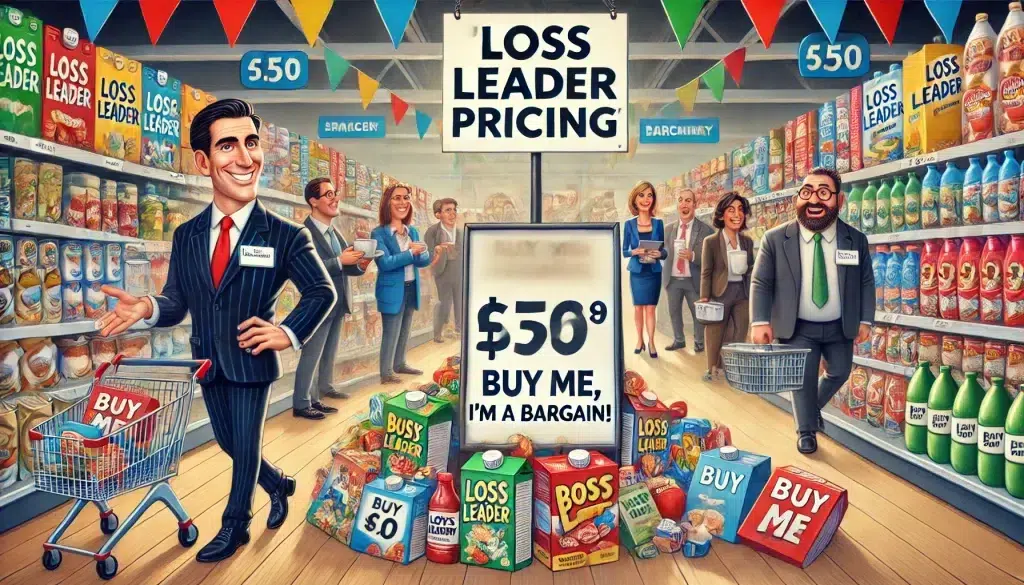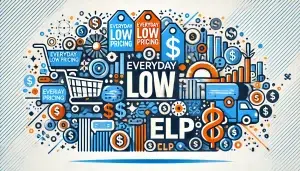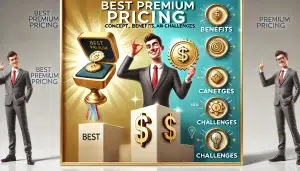
Loss leader pricing is a bold tactic used to attract customers by offering products at a loss. The aim is to draw customers in, expecting them to buy additional items that compensate for the initial loss.
This strategy can drive significant traffic and boost sales, making it a powerful tool for retailers. However, it also carries substantial risks if not implemented correctly.
For example, some customers might only purchase the discounted items and nothing else.
Despite these challenges, loss-leader pricing can increase brand awareness and attract new customers when used wisely. Studies show that 87% of retailers, including loss leaders, use promotions to increase traffic during peak shopping seasons.
Let’s explore the key benefits of using this strategy effectively.
What is Loss Leader Pricing?
Loss-leader pricing is a tactic where businesses sell products at a loss to attract customers. The goal is to draw customers into the store or onto the website with these attractive deals, anticipating they will buy additional, more profitable items.
Here are some detailed explanations of how loss leader pricing works:
- Product Selection: Items chosen as loss leaders are typically high-demand, essential products that customers frequently purchase.
For instance, supermarkets might sell staples like milk or bread at a loss because these items drive frequent store visits.
- Customer Attraction: The significantly reduced prices on loss leader items are designed to attract many customers. Once customers are in the store, they are expected to make additional purchases, increasing overall sales volume.
- Boosting Sales of Complementary Products: Businesses often use loss leaders to boost sales of complementary products.
For example, a store may sell a coffee maker at a low price, expecting customers to buy higher-margin coffee beans and accessories.
A typical example is selling printers at a loss and making substantial profits from selling ink and toner.
- Increasing Foot Traffic and Online Visits: Loss leader pricing increases the number of visitors to a store or website.
This increased traffic can lead to more sales, as customers who come in for the deal may purchase other items.
Retailers often use this strategy during major shopping events like Black Friday and Cyber Monday, which naturally attract deal-seeking customers.
- Upselling and Cross-Selling Opportunities: Once customers are in the store, businesses use upselling and cross-selling techniques to encourage the purchase of more expensive or additional items.
For instance, a customer who buys a discounted razor might also be persuaded to purchase higher-margin razor blades or shaving cream.
Another example is selling electric toothbrushes below cost, expecting customers to purchase replacement heads regularly, sold at a higher margin.
- Brand Awareness and Customer Loyalty: Offering great deals on loss leaders can enhance brand awareness and attract new customers. Customers who have a positive shopping experience are more likely to return, fostering loyalty.
- Challenges with Modern Shoppers: Thanks to price comparison tools and apps, today’s shoppers are well-informed and price-sensitive. This makes it easier for them to find the best deals, but it poses a challenge for businesses to retain customers who might leave if they find better prices elsewhere.
- Regulatory and Competitive Considerations: Knowing the legal implications of loss leader pricing is essential, as it can be considered anti-competitive in some regions. Businesses must ensure they comply with local laws to avoid legal repercussions.
Loss-leader pricing is effective but requires careful planning and execution to ensure it leads to increased sales and customer retention without eroding profit margins. Businesses must balance attracting customers with maintaining profitability by leveraging upselling, cross-selling, and superior customer service.
The 5 Benefits of Loss Leader Pricing
Loss leader pricing can offer significant advantages for businesses.
Companies can attract more customers and boost overall sales by strategically pricing certain products below cost.
1. Brand Awareness
Offering unbeatable prices can create buzz around your brand.
Customers who see exceptional deals are more likely to talk about your store, share your promotions on social media, and remember your brand in the future.
This increased visibility can lead to a broader customer base and a more substantial market presence.
2. Customer Acquisition
It can attract new customers who might become repeat buyers.
By bringing in shoppers with attractive loss-leader deals, businesses can convert these first-time visitors into loyal customers.
Effective customer service and high-quality products can enhance this conversion.
3. Increased Sales Volume
The influx of customers can lead to higher overall sales.
When shoppers come in for the loss leader products, they will likely purchase additional items sold at a regular or higher margin.
This increase in overall sales volume can significantly boost a company’s profitability.
4. Inventory Management
Using loss leader pricing can help clear out old or excess inventory.
By offering slow-moving or seasonal items at a reduced price, businesses can make room for new stock.
This strategy helps reduce storage costs and minimize losses from unsold goods.
5. Competitive Advantage
Implementing loss leader pricing can give businesses a competitive edge in the market. By offering certain products at unbeatable prices, companies can attract customers away from competitors.
This can help to increase market share and establish the business as a cost-effective option in the eyes of consumers.
The Risks and Disadvantages
While loss leader pricing can be beneficial, it also comes with significant risks.
Businesses must carefully manage these challenges to avoid potential pitfalls.
1. Price Shoppers
Customers drawn in by low prices might only buy the discounted items, not the more profitable ones. This behavior, known as “cherry-picking,” can result in a loss for the business if customers do not purchase additional products at regular prices.
Retailers must employ strategies like product bundling or upselling to mitigate this risk.
2. Legal Issues
In some countries, loss-leader pricing is illegal or heavily regulated. Regulations aim to prevent anti-competitive practices that harm smaller businesses or disrupt market equilibrium. Companies must comply with local laws to avoid legal repercussions and potential fines.
3. Financial Strain
Small to medium businesses might struggle with the initial losses and may not recover costs. Loss leader pricing requires significant financial resources to sustain the initial hit on profit margins. Smaller businesses, in particular, need to be cautious and ensure they have the financial backing to withstand the losses until they see a return on investment.
4. Price Perception
Customers may come to expect consistently low prices, making it difficult to raise prices later without backlash. If shoppers get accustomed to frequent deep discounts, they might resist paying regular prices in the future. This can erode the perceived value of the products and make it challenging to return to regular pricing strategies.
How to Implement Loss Leader Pricing – Step-by-Step
Consider the following steps to successfully implement a loss-leader pricing strategy. Each step is crucial for ensuring the strategy attracts customers while maintaining profitability.
Step 1 – Identify the Right Products
Choose essential products but not the primary revenue drivers. Products that require complementary purchases (like printers needing ink) are ideal. For example, selling a printer at a loss can drive the sale of high-margin ink cartridges. Similarly, grocery stores might sell staple items like milk or bread at a discount to drive traffic and encourage the purchase of additional groceries.
Step 2 – Limit the Offer
Set clear limits on the loss-leader items. This could be through limited-time offers, quantity restrictions, or bundling with other products. Limiting the duration or quantity prevents excessive losses and encourages a sense of urgency among customers. For instance, a store might restrict the purchase of a discounted television to one per customer during a Black Friday sale.
Step 3 – Leverage Cross-Selling
Encourage customers to buy additional items. For instance, placing loss-leader items next to higher-margin products can increase the chance of additional purchases. In a supermarket, discounted eggs might be placed next to baking supplies to encourage additional sales. Online, showing related products on the same page as the loss leader can prompt customers to add more items to their cart.
Step 4 – Analyze Market Laws
Ensure compliance with local laws to avoid legal issues. Understanding the regulatory environment is crucial before implementing this strategy. Some regions have strict regulations against loss-leader pricing to prevent anti-competitive practices. Businesses must research and adhere to these regulations to avoid fines and legal trouble.
Step 5 – Monitor and Adjust
Continuously track the performance of your loss-leader strategy. Be ready to adjust your approach based on sales data and customer behavior. Regular analysis helps determine if the strategy is driving the desired results. If customers only buy the loss-leader items without additional purchases, adjustments may be needed, such as enhancing cross-selling efforts or changing the loss-leader product.
Wrapping Up
Loss-leader pricing can be a powerful tool to boost traffic and sales, but it must be used wisely. You can mitigate risks and maximize benefits by carefully selecting products, setting limits, and leveraging cross-selling. Staying informed about legal regulations and being prepared to adjust your strategy as needed is crucial. Continuous monitoring and flexibility are key to ensuring the strategy remains effective and profitable.
Pricefy can help you implement and optimize your loss-leader pricing strategy. With advanced analytics and real-time market data, Pricefy allows you to select the right products, set appropriate limits, and track performance.
Our platform ensures compliance with local regulations and provides insights to fine-tune your strategy, maximizing customer acquisition and profitability.




